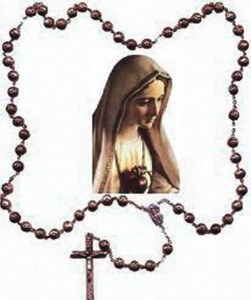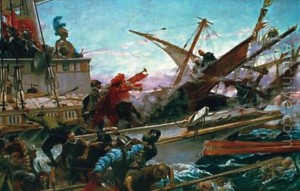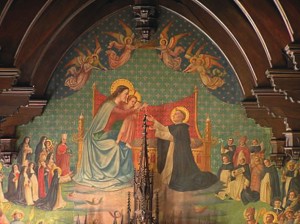Catholic Devotions
The Rosary and the Scapular - a Brief History
“The Rosary and the Scapular are inseparable.”
Our Lady to Lucia Santos at Fatima in 1917.
When Our Lady appeared to Lucia Santos at Fatima in October 1917, she carried the Rosary in one hand and the Brown Scapular in the other, signifying their importance and speaking of them as being “inseparable”. Though most Catholics are familiar with the Rosary, many are less so with the Scapular. So, how did these devotions originate?
Tradition has it that in the 13th century, the Blessed Virgin appeared to Saint Dominic, ‘giving’ him the rosary and telling him she wished to be known as Our Lady of the Rosary. Though many theologians disagree with this, stating there is no mention in writings of his life or evidence that the early Dominicans were aware of it, there is little doubt that the Rosary has been an important part of Dominican practice throughout the ages. It’s undisputed that St Dominic preached its devotion – though perhaps not the Rosary we know now - and many popes have linked him to it.
The English word ‘bead’ comes from ‘bid’ which meant to pray or to request. ‘Rosarium’ or ‘rose garden’ was a term used to describe a series of tales or accounts along the same lines or topic. Though the praying on beads as we know it, stems back to the Middle Ages, it’s believed to go much further back to pre-Christian times. There’s a story too of St Anthony, in the third century, using pebbles to recite his prayers. In the 12th century, religious orders used beads to pray the 150 Psalms and eventually these were replaced with the Our Father and the practice became known as the Paternosters. Craft guilds which made up the beads grew throughout Europe; Paternoster Row in London was one such gathering place.
It was in the 15th century that the seeds of the present day Rosary were first sown. Carthusian Dominic of Prussia created images of various events in the lives of Jesus and Mary to meditate upon while praying the Hail Mary, enabling the illiterate to focus on Biblical events. Another Carthusian Henry Kalkar broke the prayers down into decades, placing the Our Father before each decade. It’s thought that the Glory Be, Salve Regina (Hail Holy Queen) and Apostles Creed were also added during this century. In the late 1400s the Confraternity of the Psalter of Jesus and Mary was founded, which had the rosary at its core thus establishing the devotion firmly within the Church. It’s an organisation that still exists today.
In 1571 Europe was in the grip of conflict with the Moslems and when the Italian coast came under threat of attack, Pope Pius V arranged a fleet of vessels to go into battle. Before they set sail the Pope requested Rosaries be said asking people to pray for our Holy Mother’s intercession, giving her the title Our Lady of Victory. The blue banner of Christ crucified was mounted on the Christian flagship and despite being small in numbers compared to the Moslem armies, on the 7th of October 1571, the Christians were victorious in what became known as the Battle of Lepanto. One year later on the anniversary of the battle, in thanksgiving to Our Lady for her help, the Pope made the 7th of October the Feast of the Holy Rosary.
In the early 16th century the meditations were broken down into groups of five decades and became known as the Joyful, Sorrowful and Glorious Mysteries. The Joyful mysteries focus on the lead-up to the birth of Jesus and His early life, the Sorrowful concentrate on Our Lord’s Passion while the Glorious decades meditate on Christ’s Resurrection and Ascension as well as the Coronation of Our Lady.
Thanks to Pope Leo XIII in the 19th century, the rosary surged in popularity. He produced twelve encyclicals and five Apostolic letters on the rosary and encouraged its daily use in the month of October, adding the Queen of the most Holy Rosary to the Litany of Loreto in 1883. It became an integral part of Catholic tradition.
According to Pope Leo, who became known as the Rosary Pope, the rosary was “the one road to God, from the Father to the Son, to His Mother and from her to the human race.” He went on to say that “as no human creature can change this, therefore there exists only one road for the faithful, to the Mother and from her to Christ and through Christ to the Father.” The rosary then leads us, through our Blessed Mother to her Son.
In the 20th century it was Pope John Paul II who took the rosary to another level. In October 2002, his apostolic letter Rosarium Virginis Mariae marked the beginning of the Year of the Rosary and the introduction of the five Luminous Mysteries. Referring to the Scriptural verse, “While I am in the world, I am the light of the world” (John 9:5) the Pope said that it is during the years of Christ’s public ministry that His mystery “is most evidently a mystery of light”. He described the rosary as “the school of Mary” through which we were enabled to share her Son’s “deepest feelings”. He then entrusted to “the power of this prayer…the cause of peace in this world and the cause of the family.”
“Like the Rosary, the Brown Scapular has become the badge of the devout Catholic” (Catholic Encyclopedia 1914). Also like the rosary, tradition tells that it was born out of a vision. In the Middle Ages a community of hermits left their homes, the caves on Mount Carmel, and travelled to Europe, some settling in parts of the Continent while others went to the south of England. There they met Simon Stock who eventually became the Prior General of the Carmelites, basing themselves in Aylsford, Kent where there is still a Carmelite monastery today. 
Simon was, according to a 14th century account, “a man of great holiness and devotion”, whose love of Our Blessed Mother was renowned. It’s said that when he was praying to her one day, she appeared to him holding the Brown Scapular and promising her commitment to all Carmelites. The Scapular, she said,”shall be a sign of salvation,
a protection in danger and a pledge of peace. Whosoever dies wearing the Scapular shall not suffer eternal fire.”
For the monks, this just reinforced their dedication to Our Lady who had always been an integral part of the Carmelite Order. It’s believed that when the Holy Family returned to Nazareth from exile in Egypt, they visited the hermit community on Mount Carmel, resulting, not only in their acknowledging Jesus as the Messiah but the beginning of the Carmelite’s devotion to His Blessed Mother. They became known as the “Brothers of Our Lady of Mount Carmel”.
The scapular too was significant. In the Middle Ages, this was the name of part of a monk’s habit which consisted of two long strips of cloth, joined at the shoulders (scapulae ‘shoulder’) with one part draped down the back and the other down the front. To the monks, wearing the garment this way was a symbol of the yoke that Jesus spoke of as being “easy” (Matt 11:30) and was a tangible reminder of their dedication to Christ.
The small brown scapular that we now know came into being around the end of the 16th century. Two small pieces of cloth, one containing a picture of the Sacred Heart of Jesus and the other of Our Lady of Mount Carmel, were linked together by two pieces of ribbon or cord, making it easily able to slip over the head. Its popularity became widespread. Ordinary people, drawn by the deep spirituality of the Carmelites, embraced it as a means of connecting themselves to the Order and in turn, to Mary.
In the centuries since then, the Scapular of Our Lady of Mount Carmel has become the most well known of the scapular devotions within the Catholic Church. In 2001, on the 750th anniversary of St Simon’s vision, Pope John Paul II, in a letter to the Carmelite Order said that “the most genuine form of devotion to the Blessed Virgin expressed by the humble sign of the Scapular, is consecrated to her Immaculate Heart”. He spoke of two truths evoked by the sign of the Scapular: “On the one hand, the constant protection of the Blessed Virgin, not only on life’s journey, but also at the moment of passing into the fullness of eternal glory; on the other the awareness that devotion to her cannot be limited to prayers and tributes in her honour on certain occasions, but must become a ‘habit’”. The Pope admitted that he had worn the Scapular of Carmel over his heart “for a long time”, in fact since he was 10 years old. When he was hospitalised in 1981 after an assassination attempt he refused to allow the doctors to remove it.
Enrollment in the Scapular is open to any baptised Catholic. Details are on the Carmelite website.
Pope Paul VI said, “Let the faithful hold in high esteem the practices and devotions to the Blessed Virgin…the Rosary and the Scapular of Carmel.” What better way to honour our Holy Mother than to heed these words.



 Entries(RSS)
Entries(RSS)